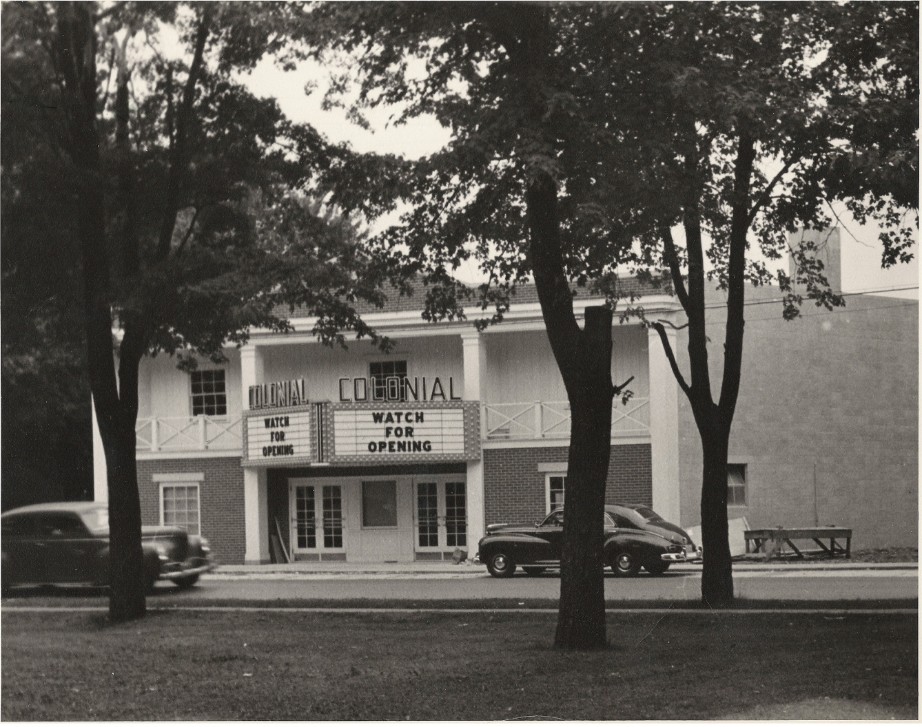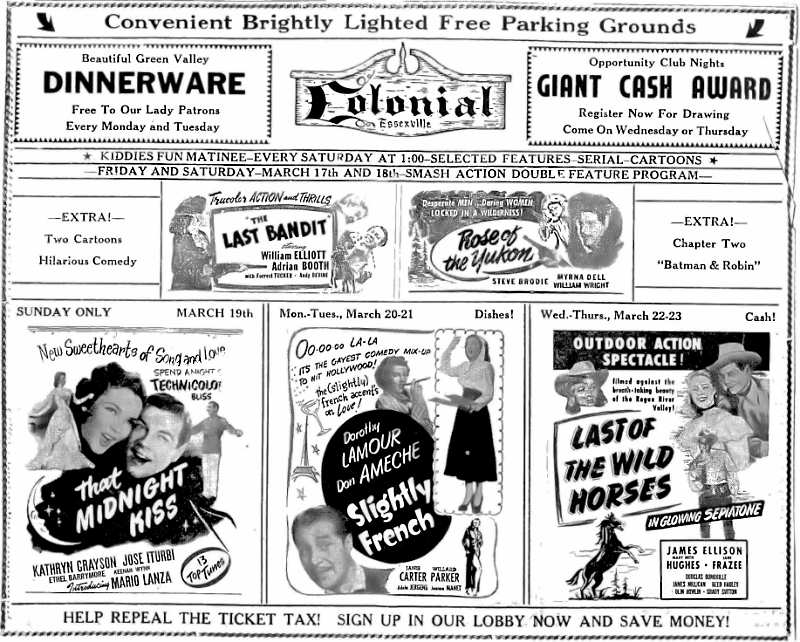
In the summer of 1947, Alfred Hamlin of Essexville and his partner Thomas Arnold of Saginaw opened the Colonial Theatre. The opening film was “My Wild Irish Rose” on a Wednesday evening. At that opening night performance, the audience filled about three fourths of the 400 seats. It was to foreshadow the operation of the theatre its first year as it struggled to entice the residents of Essexville and suburbs to come away from the large first-run downtown theatres in neighboring Bay City, just a few miles west. Even though it had innovative (at the time) push-back seats and the latest RCA projection and sound equipment, it lacked air conditioning. The fan cooling system worked well on cool evenings however.
Although Essexville is a separate city, it lies adjacent to Bay City. Normally, each town had its own “first run” theatre. Because of its close proximity to Bay City, the Film Distributors considered the Colonial to be a “neighborhood” theatre and refused to allow films to be shown there until they had played the first run in downtown Bay City. The neighborhood houses (the nearest, the Woodside/Royal was just a few miles west) could run the movies about 4-6 weeks after the first downtown showings. This was the hardest roadblock to overcome for the “new kid” on the block. The Colonial and Woodside/Royal were on the same street which extended through both cities.
The admission at the first run theatres in 1947 was fifty to seventy five cents for adults and about fifteen to twenty cents for children. The neighborhood theatre admissions were always lower, at about thirty five and fifteen cents. This included the state sales tax which was later repealed. The Colonial, hoping to have newer films, set its opening prices at forty-four cents and twenty cents for children. Because the newer movies were not forthcoming, the management soon had to reduce prices to compete with the others.
Hamlin and Arnold had contracted with a “Film Buyer” to book the movies which also proved to be a handicap, since the Essexville audiences were more discerning than the average neighborhood moviegoer. Although the competition ran double features (two movies at one price), the booking agency scheduled only single films, as they would for any small town first run theatre. They were obviously out of touch with the needs of the Colonial.
Jack Miller of Bay City had joined the theatre as projectionist when it opened. His previous experience had been with the Butterfield theatre chain in Bay City, as well as some of the neighborhood houses operated by the Bernstein chain. Along with projection experience he had worked as a doorman and then assistant to the manager of the Bay (now the State), learning advertising, scheduling and the like. After a few months of encountering the difficulties described earlier, he suggested to the owners that perhaps they could do better booking their own films, at the Film Exchange in Detroit. Neither Hamlin nor Arnold had had previous theatre experience, but were excellent businessmen. Although the response to the new scheduling was fairly good, it was not enough to sustain the operation at a profitable level, and after one year of operation, the partners were forced to close.
In the meantime, Louis Kempa of Bay City was in contact with the partners, as he had an interest in getting into the theatre business. Kempa operated a very successful department store in Saginaw. Arnold sold his share to Mr. Kempa, and he, along with Hamlin, reopened the theatre that same summer. The opening film was a James Stewart comedy, “You Gotta Stay Happy”. A fitting title for the new venture, which this time proved to be more successful. It was obvious that many Essexvillians missed their movie house. A year later, Kempa became sole owner of the business and operated it successfully until the early 60’s. By then, television was taking its toll on small town theatres.
During the 50’s however, Kempa along with Miller continued to book films, changing the policy to double features, and other typical attendance incentives, such as free dishes on Mondays and Tuesdays, and an “Opportunity Night” which was a lottery type money giveaway. Business boomed, with capacity audiences. Only one feature was shown on those nights, so two performances could be given. In those days, matinees were only popular on weekends, which also included “Kiddies Matinees” on Saturdays, with westerns, serials and cartoons. The admission prices remained stable, and the ticket tax was repealed.
In 1950, two other significant events took place. There was a large area behind the projection room which Kempa remodeled into an apartment, so he and his wife could be closer to the operations and still continue to operate the store in Saginaw. Also, a new local newspaper, “The Essexville-Hampton Herald” began with Charles Hamilton at the helm as editor. He maintained his offices for a time in the theatre building.
Late in the 50’s, an addition to the building was built, housing a family restaurant on the main floor, and a large hall suitable for wedding receptions, etc. on the upper floor. This added to the success of both the theatre and the restaurant.
There continued to be the “regulars” in the area who seemed to attend every film shown, even when the programs changed four times a week. One of those was a Mr. Darling, who operated a grocery store just a block away. Although handicapped and in a wheel chair, he never missed a performance. When big productions such as “The Ten Commandments” were shown, the distributor required a minimum run of one week, retaining 70% of the gross. This was the beginning of what is commonplace in today’s cinemas. Many theatres in that era contracted with concessionaires to operate their candy and popcorn sales, but Kempa with his department store experience, ran his own….another profitable idea. He was one of the first to add the sales of soft drinks as well.
As television became more popular in homes, the theatre business declined. Around 1960, the Colonial operated only on weekends. Nearing retirement age, Kempa sold the business to a Mr. Sciattone, who operated the restaurant and hall and leased the theatre operation to Ed Johnson, operator of the Washington and Westown Theatres in Bay City. In the late 60’s the theatre closed permanently. The building remains, minus its marquee, and the current owner uses it for storage and has dreams of re-opening it someday. There has begun a small resurgence of small town theatres being restored throughout the country and one can only hope that the Colonial might be one of them.
